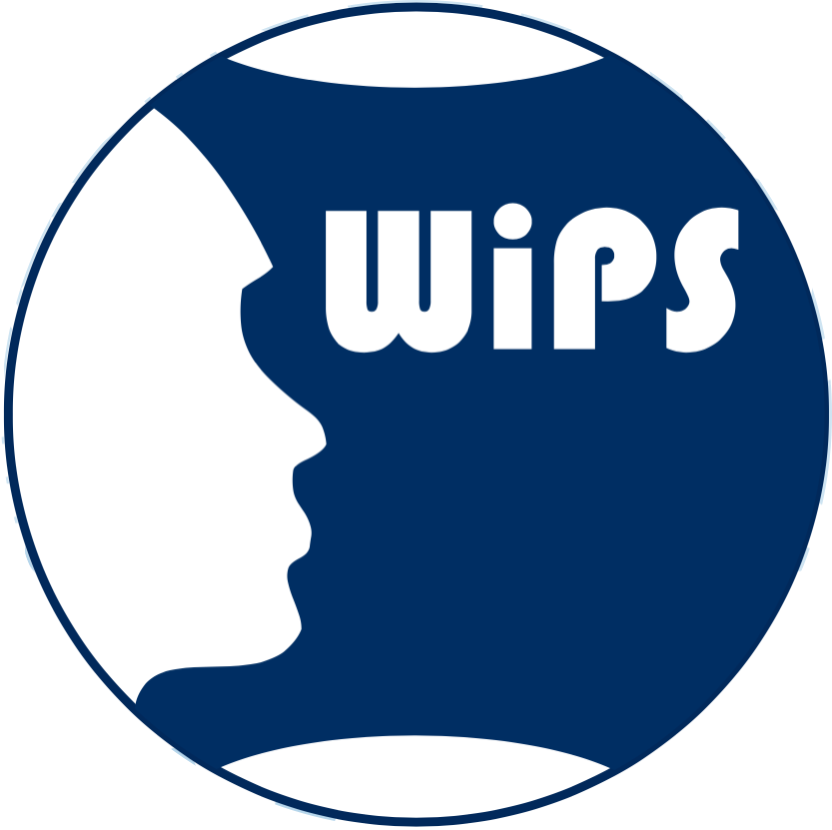Meet 100 Women in Polar Science and Support!
We’re collecting stories from 100 global women in polar employment, both polar science and non-academic polar roles. Check them out here – updated weekly!
Our thanks to the Curtis and Edith Munson Foundation for funding this project, The Ocean Foundation for acting as the US fiscal sponsor, and the Scientific Committee on Antarctic Research (SCAR) for their support.
Want to feature or know a cool woman who should? Contact us!
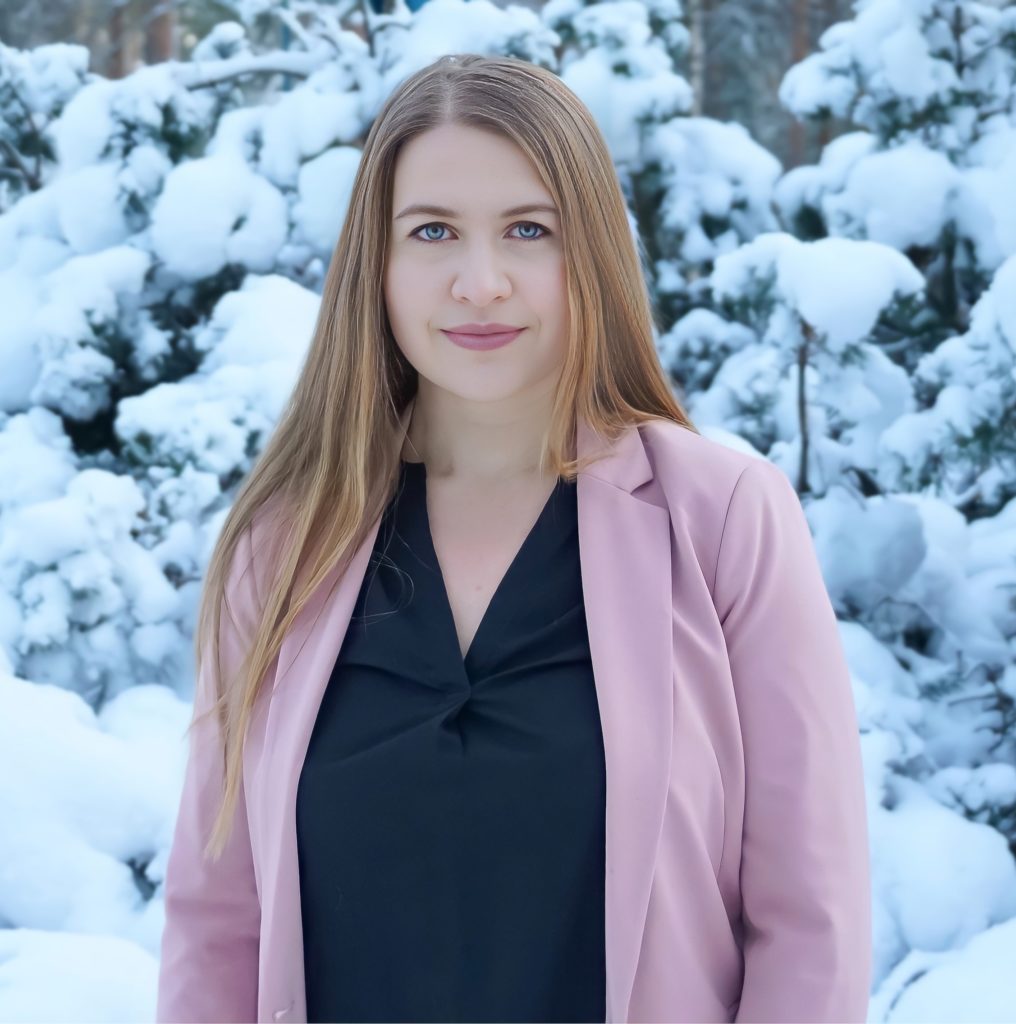
Alexandra Middleton, PhD
Discipline: Sustainable development in the Arctic
Nationality: Finland
Organisation: Oulu Business School, University of Oulu (Finland)
Regional focus: Arctic
Social media: LinkedIn and Twitter
What’s the work that you do?
In my research, I examine the sustainability aspects of Arctic development, with a particular focus on economic, social, and environmental sustainability. By analyzing demographic, economic, and social indicators of Arctic regions, I seek to gain a deeper understanding of the transformations occurring in this region as a result of both global economic forces and climate change. I prioritize examining the human aspect of socio-economic changes in the Arctic. Additionally, my research investigates questions related to the resilience of Arctic regions, their innovative capacity, energy security, and connectivity solutions.
What keeps you going?
My natural curiosity and love for writing led me to the world of science, where clear and precise expression of facts and ideas in research is paramount. I am passionate about science diplomacy, particularly in the Arctic, and have shared knowledge with the UK Parliament Environmental Audit Committee. I write for the High North News and use social media to make science open and available to everyone. Additionally, I spoke at TEDxOulu in 2020 about the human dimension of Arctic challenges and opportunities, aiming to counter global media-driven prejudices.
What’s your message to the world?
As a social sciences researcher, I have had the privilege of studying the Arctic from a broader perspective, focusing on socio-economic trends taking place in this unique region. I feel a deep sense of responsibility to share with the world the truth about the Arctic—what happens to the people, to communities, and what the trends are. It is my hope that by doing so, we can conduct business in the Arctic sustainably and with respect to local knowledge and concerns. In my research, I have come to understand that innovation in the Arctic is born from a deep connection to the land and sea, and from the traditions and knowledge passed down through generations. Only by understanding and respecting these local voices, both indigenous and non-indigenous, can we have a sustainable Arctic. I want to take this opportunity to urge all stakeholders to start practicing Arctic leadership. This means listening to local voices, understanding trends, and respecting the environment, Arctic biodiversity, and ecosystems. We must take responsibility and make conscious decisions that reflect Arctic leadership and accountability. Together, we can create a more sustainable future for the Arctic and for all of us.
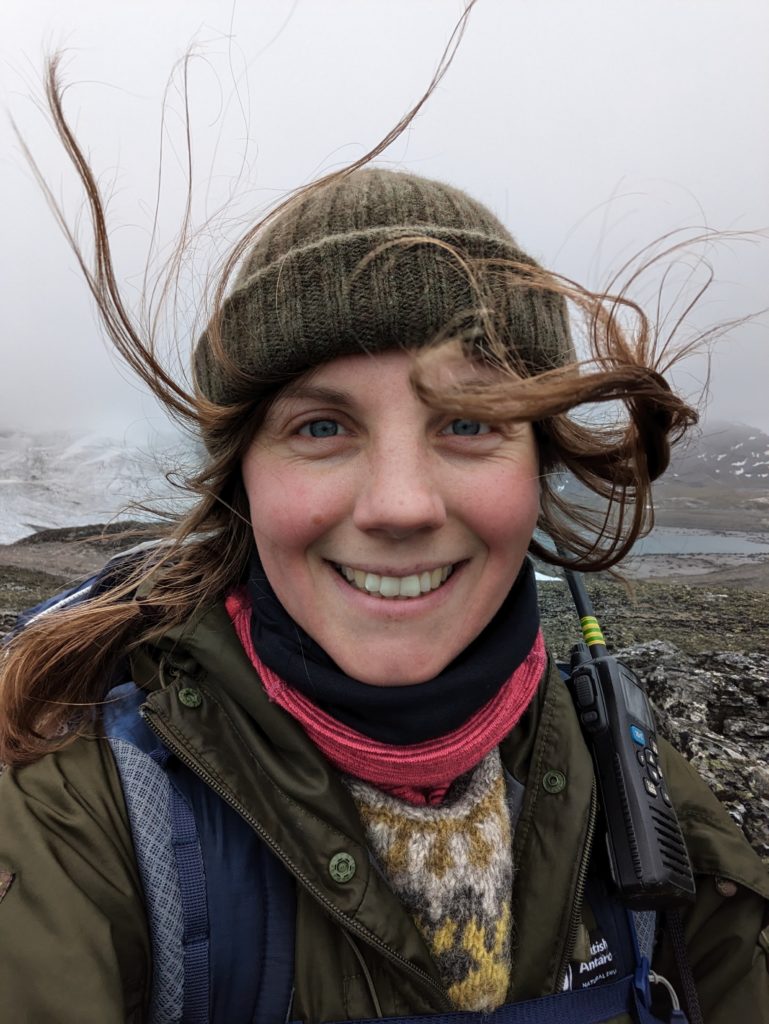
Ingeborg Klarenberg, PhD
Discipline: Plant and microbial ecology & conservation biology
Age: 34
Nationality: The Netherlands
Organisation: Vrije Universiteit Amsterdam (The Netherlands)
Regional focus: Arctic and Antarctic
Social media: Website and ResearchGate
What’s the work that you do?
I am a terrestrial ecologist. I study microbes, invertebrates and lichens and mosses in the (sub-)Arctic and Antarctic, for instance in the light of climate warming, but also their role in primary succession when glaciers retreat. I am currently working on moss- and lichen-associated biodiversity in the Antarctic.
What keeps you going?
I have been fascinated by biodiversity from a young age, and later on by the ecosystems in the higher latitudes. For me, the polar regions are a playground to understand how extreme climates and landscapes set the stage for physical and biological processes from landscape to the microbial scale. I feel extremely lucky to have a job that combines fieldwork in remote regions, collaborations with other motivated researchers and working with data to explore new knowledge territories that will hopefully lead to better future protection of the poles.
What’s your message to the world?
The polar regions feel like far-away lands and oceans that exist independently of us, but our way of life is felt in the polar regions and what happens at the poles doesn’t stay there. I hope we will realize that preserving the poles will directly benefit us and that it is worth to change our behavior (even if only for the beauty of these regions) and to put pressure on companies and governments to do the same.

Katherine Hobbs
Discipline: Science Communication, penguin studies, wildlife conservation
Age: 28
Nationality: UK
Organisation: NPR’s KERA and 18 Species Productions
Regional focus: Antarctic
Social media: Twitter and Instagram
What’s the work that you do?
My academic work focuses on identifying correlations between captive and endemic Gentoo penguins’ phylogenetic trees via analyses of their mtDNA and observable behavior with the goal of ensuring genetically diverse ex-situ populations. As a science communicator, both as an environmental journalist and documentary filmmaker, I aim to educate people about the wonders of Antarctica and the interconnectedness of polar ecosystems. I believe that the most effective way to encourage change is by helping people foster a personal connection to the land and species that call it home.
What keeps you going?
I am autistic, and I am absolutely wonderstruck by Antarctica. The frozen continent feels like an extension of myself. Through years of research and immersing myself in every photograph, research paper, documentary, and logbook that I can get my hands on, I have learned more about myself. My understanding of climate change, wildlife conservation and the intricate Antarctic ecosystems has led me closer to myself. Parts of my brain that felt as unknown as the uncharted crevices of Antarctica have come into view. This self-discovery, paired with an obsessive hunger for information, keeps me going.
What’s your message to the world?
Antarctica represents the best in humanity. Countries from around the world banded together to sign the Antarctic Treaty. Folks who will likely never set boots on the ice are invested in preserving it. The continent is a time capsule. Humans coming together to learn from the land, listen to what it can tell us about the future of climate change, and discover mysteries of our past through ice-core sampling is such a beautiful thing. To be able to do my part in educating others about the wonders of Antarctica is a privilege as massive as the continent itself.
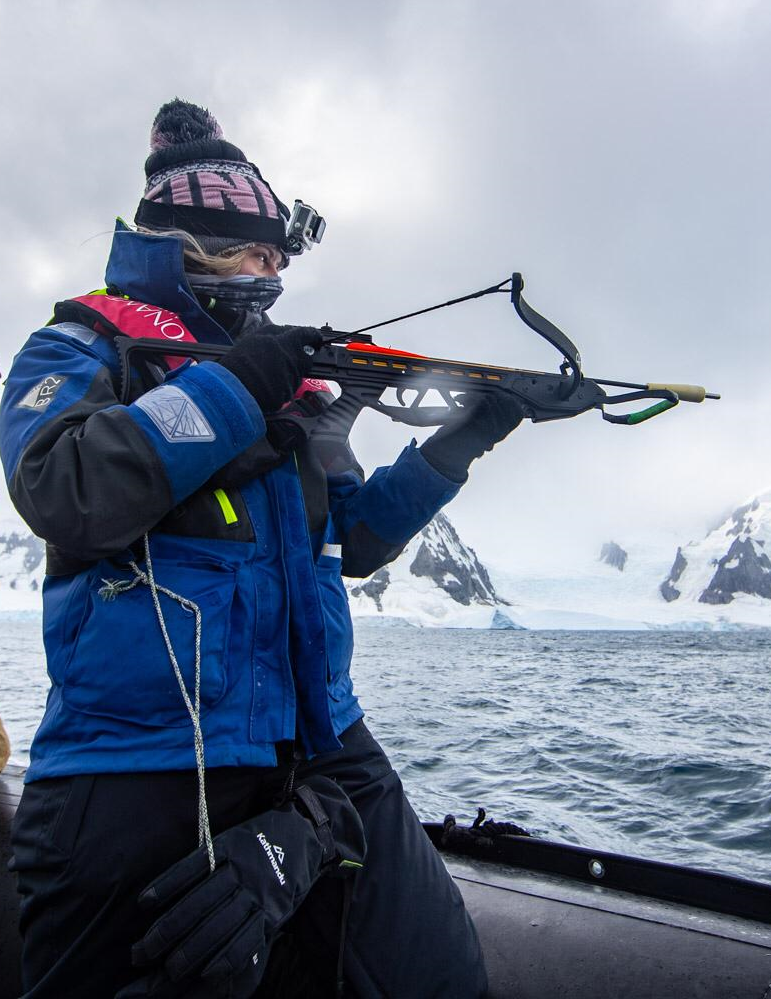
Leena Riekkola, PhD
Discipline: Spatial ecology & conservation biology
Age: 35
Nationality: Finland and New Zealand
Organisation: University of Auckland (New Zealand)
Regional focus: Antarctic
Social media: Twitter and ResearchGate
What’s the work that you do?
I use satellite tracking, quantitative analyses, and modelling to understand where animals are in space and time, and what factors drive their movement and behaviour. Through my work I provide critical information to conservation and government agencies, allowing them to make well-informed decisions around reducing human impacts on animal populations. My new project focuses on the movements of southern right whales across the Southern Ocean. I aim to identify key feeding habitats in the vast yet poorly understood Southern Ocean, to discover how these habitats have changed over time and how they might shift in the future.
What keeps you going?
In this line of work there is always something to discover, some problem to solve, and something new to learn. Every day is different, and sometimes also a challenge, but my curiosity and passion for discovering new things keep me going. I’ve also been very fortunate to have worked with the most wonderful and passionate people who have really made research enjoyable, and without whom I wouldn’t be where I am today. Also, the occasions when I get to escape the office and travel to amazing places such as Antarctica and the sub-Antarctic for fieldwork are the highlights of my year!
What’s your message to the world?
Be kind to yourself, to others, and the planet that we share. The best each of us can do is to do our best. But we’re all in trouble if we can’t see further than our own noses. Instead, the world would be an amazing place if everyone followed the guidance of the Greek Proverb “a society grows great when old men plant trees in whose shade they shall never sit”.

Rúna Magnússon, PhD
Discipline: Permafrost and tundra ecology
Age: 31
Nationality: The Netherlands
Organisation: Wageningen University (The Netherlands)
Regional focus: Arctic
Social media: LinkedIn and website
What’s the work that you do?
I work as a lecturer and researcher at a plant ecology institute and I study relations between climate change (rainfall extremes in particular), tundra vegetation growth and permafrost degradation in Siberia and Svalbard. I use field experiments, remote sensing and dendrochronology.
What keeps you going?
The beauty and stillness of polar ecosystems is tremendously inspiring and important to me. I want to contribute to conserving it by studying the impact of future climate changes and extremes in the field and sharing my research and stories with students and a general audience.
What’s your message to the world?
Just like with people, the toughest ecosystems can also be the most sensitive ones.

Maria Fernando
Discipline: Electrical and Wind Engineering
Age: 30
Nationality: New Zealand
Organisation: Antarctica New Zealand
Regional focus: Antarctic
Social media: Instagram and LinkedIn
What’s the work that you do?
I help keep the power on at Scott Base, New Zealand’s Antarctic research station at Pram Point, Ross Island. I work as the Electrical and Wind Engineer for Antarctica New Zealand and primarily manage our generators at Scott Base and the wind turbines behind it on Crater Hill.
What keeps you going?
What keeps me going is that my job directly ensures that science can happen. I enjoy the variety of work that comes with problem solving, particularly getting things to work within the conditions we face (i.e the cold) and the constraints of what we have available as spares – the hardware shop isn’t exactly down the road! I enjoy working within a diverse, capable team and knowing my work is making a difference.
What’s your message to the world?
There is still time to solve the climate crisis! We need to work together though. Polar science is a big piece of the puzzle and enabling evidence of the change is important to be able to tell the story.

Dilia Martínez-Méndez, MSc
Discipline: Medicine
Age: 46
Nationality: Venezuela and Spain
Organisation: Research vessels
Regional focus: Antarctic
Social media: LinkedIn and Orcid
What’s the work that you do?
I’ve worked as a remote site medical doctor since 2014, in extreme locations like Antarctica, remote Africa, and in the oil & gas industry, where I operated as a a member of multicultural teams. I’ve been the team leader for Emergency Response, providing medical care (ACLS – PHTLS – OSHA), writing medical reports and serve as liaison to bases & medevac. I also monitor & do CME on the crew. Finally, I do more mundane tasks such as managing inventory supplies and orders.
What keeps you going?
I’ve been a physician since 2002, with experience in infectious diseases & research. When I had to leave my country in 2016, I had to refresh my knowledge of emergency medicine, occupational health and safety. In line with this, I became a remote site doctor debuting in Antarctica, where I was the only health personnel onboard of an expedition ship during the entire 2016-17 season as well as the 2017-18 season. Working as a member of multicultural teams, speaking another language, and doing things as well as possible is a challenge! Now, adding everything I’ve learned, I continue to do research, I publish, review, and collaborate as a speaker. I am always willing to learn, and this keeps me going.
What’s your message to the world?
You can complain because things didn’t turn out the way you wanted, the way you planned, the way you dreamed, or you can want the things you do, plan new horizons and enjoy peaceful nights of sleep. You decide if you use your talent to create or to complain! Read it out loud: It’s up to YOU.

Linda Brewer
Discipline: Anthropology
Age: 60
Nationality: USA
Organisation: T-3 Strategies LLC
Regional focus: Arctic
Social media: LinkedIn
What’s the work that you do?
I work in sustainability – working with communities and organizations on issues of the environment and the social aspects surrounding it. I grew up in the Arctic – in Utqiaġvik, Alaska, where my father ran the Arctic Research Laboratory, and I was exposed to Arctic Sciences. I have delivered social research projects in the Arctic, working with the Iñupiat peoples. I served on the North Slope Sciences Initiative, Science Technology Advisory Panel for the US DOI. I am particularly interested in the application of the thousands of years of Traditional Ecological Knowledge to global and local development projects.
What keeps you going?
Working and living in the Arctic is a part of who I am and have always been. It is, most simply, my home and as such I keep returning there, no matter where in the world I roam. I continue to look at the intersection of the circumpolar Arctic, its people, and other cultures, search for more data, information, and clarity.
What’s your message to the world?
The experience of the Arctic and Sub-Arctic peoples of Alaska needs to be input into our planning, particularly in the area of Climate and sustainability.
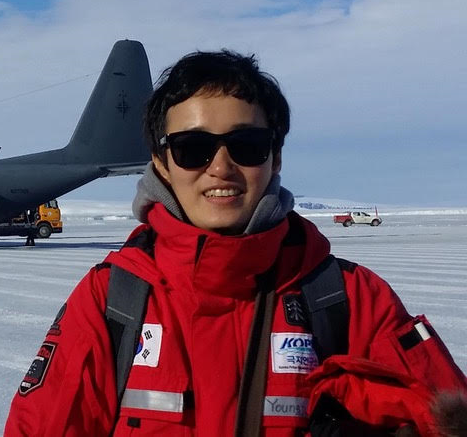
Youngju Lee, PhD
Discipline: Marine Phytoplankton Ecology
Nationality: Republic of Korea
Organisation: Korea Polar Research Institute
Regional focus: Arctic and Antarctic
Social media: ResearchGate
What’s the work that you do?
As a marine phytoplankton ecologist, I focus on studying how phytoplankton communities in the polar oceans respond to environmental changes. Specifically, I am interested in investigating the spatial distributions of phytoplankton species composition and biomass, as well as their temporal changes, onboard the icebreaker research vessel ‘Araon’ in the Antarctic and Arctic Oceans, and at the Korean scientific stations in Antarctica.
What keeps you going?
Marine phytoplankton in polar oceans exhibit distinct physiological and ecological characteristics when compared to those in tropical and temperate oceans. However, they are often understudied due to the challenges of accessing these remote areas. Despite these challenges, uncovering their secrets in the unknown areas of the ocean keeps me going. I hope that these studies will help to raise awareness and preserve the stunning ice worlds in Antarctica and the Arctic ocean.
What’s your message to the world?
Are you finding it hard to breathe due to fine dust? Are you stuck at home due to COVID-19? Let’s show some love and care for our planet. We need to consider whether our careless actions are causing harm to our beautiful planet. If we fail to act, the consequences of our actions will eventually come back to haunt us. A beautiful coastal city might be submerged under the sea. Time is running out, so we must act fast.

Michaela Muehl, MSc
Discipline: Climate sciences, climate physics, glaciology
Age: 32
Nationality: Germany
Organisation: University of Bern (Switzerland) and Oeschger Centre for Climate Change Research
Regional focus: Arctic and Antarctic
Social media: Instagram and Website
What’s the work that you do?
I am a third-year PhD candidate; I work in the “Past Climate and Biogeochemical Studies on Ice Cores” group. I analyze entrapped Greenhouse gases (my main focus is on methane) in ice cores from both Greenland and Antarctica to reconstruct the climate of the past. I am also part of the BeyondEPICA project; I will participate in the coming Antarctic field season (Nov 2023- March 2024) at Little Dome C to continue drilling the oldest ice.
What keeps you going?
There is not a single day that I don’t enjoy going to work. I like the “spirit” of research, this inquisitiveness, to learn something new every day. But most importantly, I appreciate the value of our work. The basic research is fundamental to better understand the “System Earth” with all its parts and interactions. Only with a comprehensive understanding of past climate changes and natural variability can we make reliable predictions for the future and how the Earth system will respond to human-induced climate change.
What’s your message to the world?
Look deep into nature and you will understand everything better.

Natasha Gardiner
Discipline: Social science and Antarctic environmental management
Age: 30
Nationality: New Zealand
Organisation: Gateway Antarctica, University of Canterbury (New Zealand) and Antarctica NZ
Regional focus: Antarctic
Social media: ResearchGate
What’s the work that you do?
I am working on my PhD; my background is in psychology and sociology. My research explores science-policy interactions in the context of decision-making at the international level (i.e. in the context of the Antarctic Treaty Consultative Meetings (ATCM) and the Committee for Environmental Protection (CEP)) and at the domestic level here in New Zealand. In particular, I’m interested in the drivers and barriers that contribute towards ‘successful’ Antarctic science-policy knowledge exchange practices. Alongside my research, I also work as an Environmental Advisor for New Zealand’s National Antarctic Programme, Antarctica New Zealand. In this role, I’m privileged to work with some incredible humans and also contribute towards New Zealand’s engagement with the CEP. I’m also a member of the steering committee for SCAR’s SRP Ant-ICON (Integrated Science to Inform Antarctic and Southern Ocean Conservation). My role within Ant-ICON is the EMCR lead for the synthesis theme, which aims to foster mutual understandings between Antarctic research and policy communities to enrich Antarctic environmental decision-making.
What keeps you going?
In my mind, Antarctica really is the Earth’s final frontier. But everyday I am confronted with scientific evidence that speaks to a different reality – Antarctica is now victim to the same anthropogenic pressures and threats that we see all around the globe. I really believe that through innovative, courageous and bold decisions at individual and institutional levels, we can together ensure that Antarctic environments are safeguarded for their own right, but also for future generations. This belief is what drives my work!
What’s your message to the world?
Live simply so that others may simply live (that one was Gandhi, not me!)

Meredith Nash, PhD
Discipline: Sociology
Age: 42
Nationality: Australia and USA
Organisation: KPMG Banarra (Australia)
Regional focus: Antarctic
Social media: Twitter
What’s the work that you do?
After a long academic career as a cultural sociologist focusing on building inclusion in polar fieldwork, I’m now working as Director – Human Rights and Social Impact at KPMG Banarra. Our team advises business on how to manage social risks. I lead the sexual harassment service line with a focus on sexual harassment prevention in male-dominated workforces and especially in extreme environments (e.g., Antarctica, mining, space, military, etc.).
What keeps you going?
I feel lucky that I can bring my love of Antarctica and subject matter expertise on remote/extreme fieldwork to new audiences in a range of contexts related to workplace sexual harassment as a consultant. I care deeply about sexual harassment prevention. This is an exciting new chapter of a career focused on addressing gendered inequalities in everyday life from multiple angles and always with the voices of women and girls at the centre of everything that I do.
What’s your message to the world?
We are at an important cultural moment where legislation, coupled with changing cultural attitudes to sexual harassment (in many countries), means that we have a once in a generation opportunity to address sexual harassment meaningfully in polar fieldwork. Investing in psychologically and physically safe working environments is an urgent priority for National Antarctic Programs. I feel hopeful that we can make meaningful change for current and future generations of polar women.
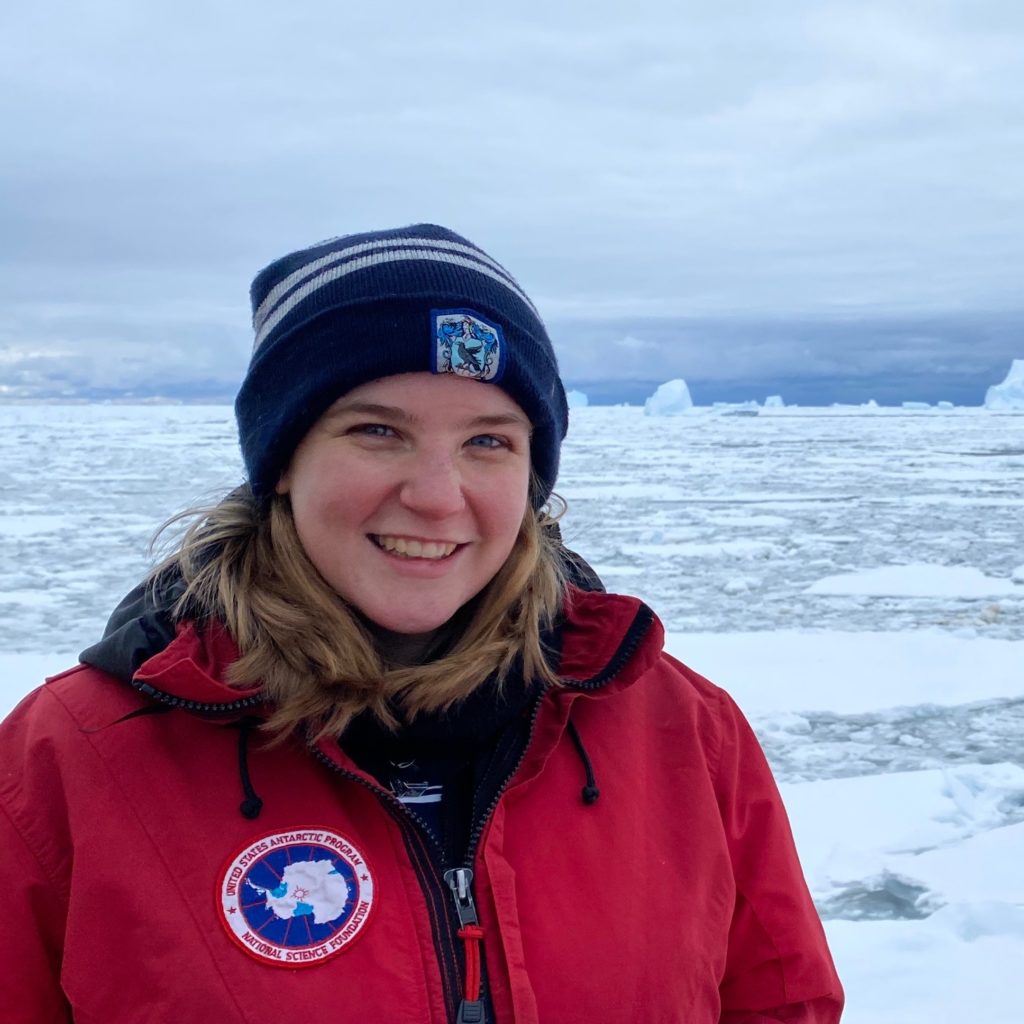
Lily Dove, PhD (tbc)
Discipline: Oceanography
Age: 26
Nationality: USA
Organisation: California Institute of Technology (USA)
Regional focus: Antarctic
Social media: Twitter and Website
What’s the work that you do?
I study the efficiency with which carbon can be transferred from the atmosphere to the deep ocean, and how ocean dynamics impact this exchange. I approach these questions by using in situ observations from autonomous vehicles and data from satellites to study interactions between ocean physics and biogeochemistry. My research focuses on the Southern Ocean, which is a driver in the global ocean circulation and climate cycle.
What keeps you going?
There are two aspects of my job that I particularly enjoy: Going to sea to collect data and doing outreach talks with local middle schools. My happy place is being out on the ocean (preferentially the Southern Ocean!) putting scientific instruments in the water, making measurements, and seeing the amazing natural landscape, even though it can get wavy and stormy at times! In addition, I love sharing pictures of my work and doing classroom demonstrations with local middle school students. Their excitement fuels me and keeps me energized about my research.
What’s your message to the world?
My most defining moment of being a polar researcher was while I was aboard the RVIB Nathaniel B. Palmer in the Amundsen Sea in March 2020. As the rest of the world began social distancing, the 60 people aboard the ship continued working together to progress the science. It was emotionally taxing and physically draining, even more than traditional field work, but I learned about how to support myself and others in trying times. I now try to carry these lessons into my day-to-day life off board the ship, too.
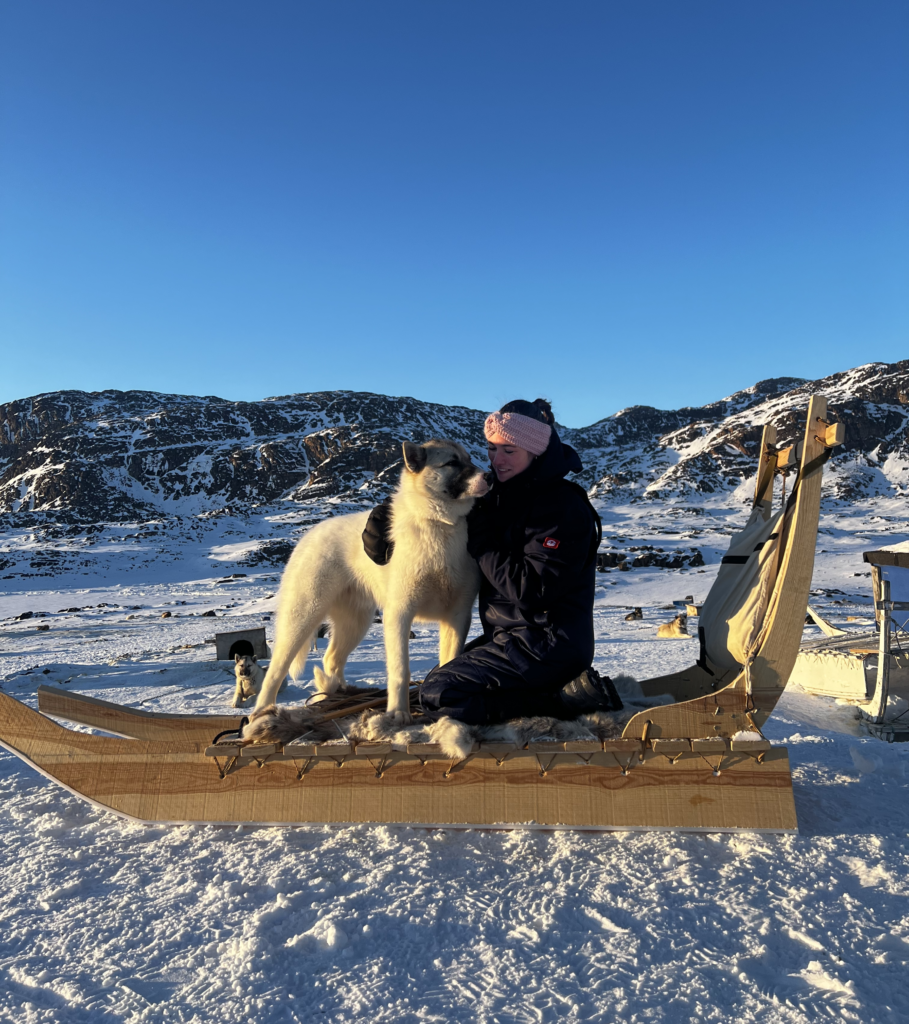
Emma Vitale, PhD
Discipline: Archaeology
Age: 29
Nationality: Denmark and Italy
Organisation: Globe Institute (University of Copenhagen); University of Greenland
Regional focus: Arctic
Social media: ResearchGate and Instagram
What’s the work that you do?
I am a Ph.d. fellow with Globe Institute at the University of Copenhagen and the University of Greenland. My research focuses on the Greenlandic dog sledding culture. My work investigates how humans exploited the domesticated dog in Greenland in prehistory, how the relationship is visible through archaeological and ethnographic evidence, and if the material culture can shed light on the origin of the Arctic dog sled complex. My research also involves a historical study of the Greenland dog sled and sled dog equipment, with identification and characterization of regional cultural traditions and variations.
What keeps you going?
My curiosity keeps me going, because it is currently an overlooked field in the world of archeology, and there is still so much to discover about dog sledding. I have always been fascinated by the historical collaboration between human and dogs, and dog sledding has been essential for humans to live, travel and settle in the Arctic climate. I feel very grateful for having the opportunity to study such an important part of the Greenlandic cultural history, and meet so many incredible people through my research.
What’s your message to the world?
Greenland holds the largest remaining sled dog population in the Arctic and a globally unique traditional culture. But both the sled dog and the culture that goes with it is threatened by extinction. I hope my work will contribute to increase the focus on research and preservation of the dog sled culture.
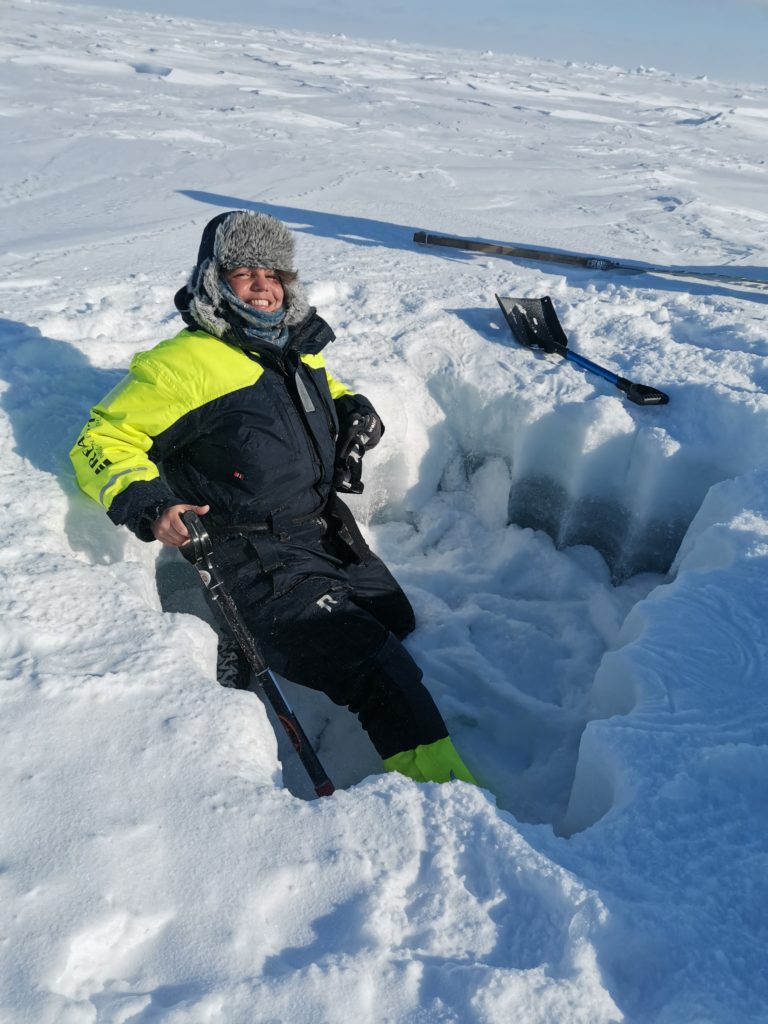
Natalie Summers, MSc
Discipline: Marine biology, polar biology
Age: 35
Nationality: Mauritius and UK
Organisation: Norwegian University of Science and Technology (NTNU); Nansen Legacy, Centre for Autonomous Marine Operations and Systems (AMOS)
Regional focus: Arctic
Social media: Instagram
What’s the work that you do?
I am using mini remotely operated vehicles (ROV) with hyperspectral cameras to map algae living in the Arctic. Each object of interest has a optical fingerprint that I can use to identify types of algaes. This way, I am able to map kelp forests and microalgae growing on the underside of the ice. I combine this with measuring photosynthetic rates to look at the health state of the algaes. Marine algae are the base of the food web. As they photosynthesis, they use up carbon dioxyde and release oxygen. The overall goal is to better understand algal dynamics in space and time in the Arctic.
What keeps you going?
I enjoy exploration and pushing the boundaries of science. Life in the Arctic has adapted to extreme cold as well as extreme light cycles (3 months of darkness and 3 months of sun). These extreme conditions have also made it challenging for researchers. Because of this I get to be part of interdisciplinary teams of researchers allowing us to develop new methods to study the Arctic. I work with marine technologists that make the robots and sensors I use to gather data, while I get to analyse and interpret the biological results.
What’s your message to the world?
Our world is fascinating and changing fast. The key is to stay curious, keep an open mind and work with as many people from different backgrounds as possible.
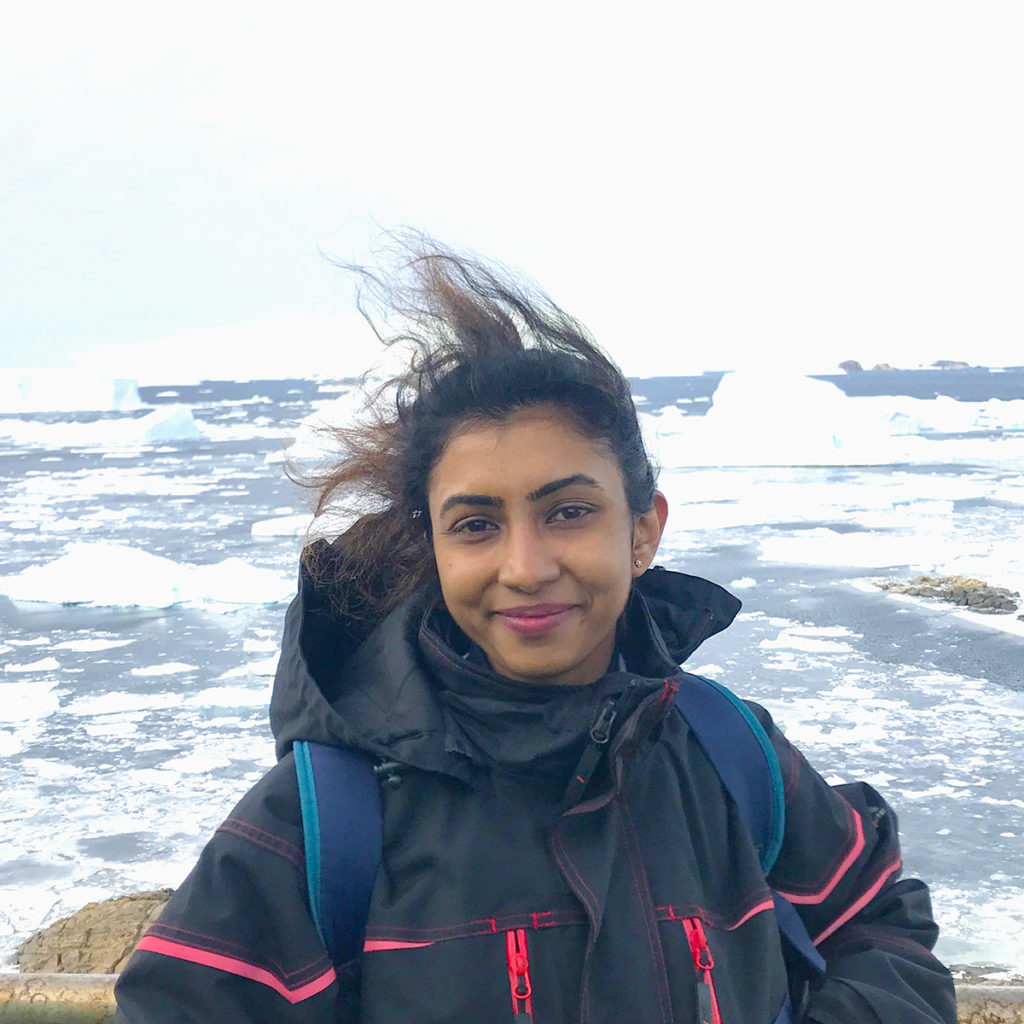
Cheryl Noronha-D’Mello, PhD
Discipline: Antarctic paleoclimate and paleolimnology
Age: 35
Nationality: India
Organisation: National Centre for Polar and Ocean Research (India)
Regional focus: Antarctic
Social media: Instagram and Twitter
What’s the work that you do?
I’m a Project Scientist who specialises in Antarctic paleoclimate and paleolimnology. My research centres around reconstructing the past climate in Antarctica using sediment cores retrieved from the lakes of ice-free oases of the Larsemann Hills and Schirmacher Oasis, East Antarctica. We want to understand environmental responses of the terrestrial and aquatic systems to past climate change over glacial and interglacial timescales.
What keeps you going?
Since hearing stories of various exploration expeditions, the idea of working in Antarctica has intrigued me. Studying past climate in Antarctica is literally time-traveling to the past to find out and interpret some knowledge that is unknown or little known. It’s like being a climate detective trying to decipher the secrets of Antarctica’s past, and you get to tell that story to the world through your research. Working in such challenging conditions on the lake on a floating platform to retrieve sediment cores in order to tell that story makes the job adventurous and exciting.
What’s your message to the world?
As I study past as well as modern climate change, I want to convey that climate change is indeed real and amplified in the polar regions. Though it has happened in the past due to natural variability, the current climate change scenario is caused by humankind and is irreversible. But, there is still scope to heal the planet by changing multiple magnifying factors, including carbon emissions and lifestyle. We need to do our part in order to preserve the beautiful and pristine region of Antarctica and all the life that it holds.
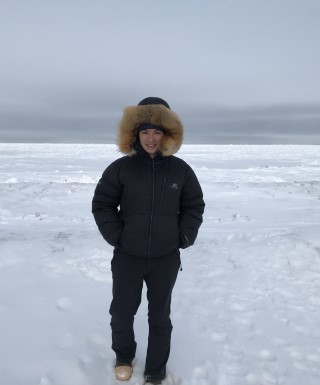
Alice Bradley, PhD
Discipline: Sea ice and Arctic observation
Age: 33
Nationality: USA
Organisation: Williams College (USA)
Regional focus: Arctic
Social media: Website
What’s the work that you do?
In classic Arctic fashion, I wear a lot of hats. I am a professor at Williams College, where I teach classes related to climate science, environmental observation, and the cryosphere. My research is in observing Arctic sea ice and how we can combine observations approaches (different satellite-based sensors, shore- and water-based in situ measurements, and community observations). I also work in coordinating observations through the Arctic Observing Summit and SAON. How can we design an Arctic Observing System that makes better use of the resources we have and be more responsive to the needs of Arctic communities?
What keeps you going?
I am deeply interested in the question of how we measure things, and that is what brought me in to polar science. From building instruments and developing remote sensing approaches to coordinating observations at international and cross-disciplinary scales, what we observe depends on how we go about observing it. Being able to indulge this curiosity and make observations and observing systems that can help communities is what motivates my work.
What’s your message to the world?
Doing things well takes time. Be patient, start building relationships and processes before you need them, and recognize that sometimes you’ll need to take two steps back in order to move forward.
Maria Ximena Senatore, PhD
Discipline: Archaeology
Age: 52
Nationality: Argentina & Italy
Organisation: Universidad de Alicante (Spain)
Regional focus: Antarctic
Social media: Twitter and ResearchGate
What’s the work that you do?
I have been doing research in Archaeology in Antarctica for more than two decades. I began in the 1990s doing fieldwork in the South Shetlands Islands to study the material remains of the first human occupations in Antarctica. Since then, my work has played a particular role, showing that in Antarctica, there are many stories that are still being studied and written that involve a multicultural past.
What keeps you going?
Archaeologists play a role as storytellers. Material things have the symbolic power to diversify the ways of telling stories because they witness the processes in which time, nature and culture act as intertwined agents articulating processes of change over time. However, archaeology is not only about the past. Archaeology, as the study of human-thing relations in a myriad of contexts and chronologies, including the present, has been critically thinking and questioning our contemporary world. In Antarctica, material things have been, while largely unnoticed, actively involved in political relations, historical commemoration and environmental protection discussions, as well as in the cultural and social processes of inhabiting Antarctica. Archaeological perspectives contribute to broadening and enriching conceptual debates about values, meanings and knowledge from the lens of a social discipline to help understand the place that humans have had in Antarctica.
What’s your message to the world?
My experience of almost three decades as a woman researcher in the field of humanities and social sciences in Antarctica has gone hand in hand with many relevant changes regarding increasing inclusiveness in polar research in many different aspects. I believe my lines of research have contributed to that process, for example, by widening the scope of Antarctic narratives and heritage to reflect on cultural diversity in Antarctica. Inclusive views need to accept that it is time for narratives to come forwards, yielding to diverse multivocal stories of different people, embracing the multicultural character of Antarctica, and engaging different communities and world visions.
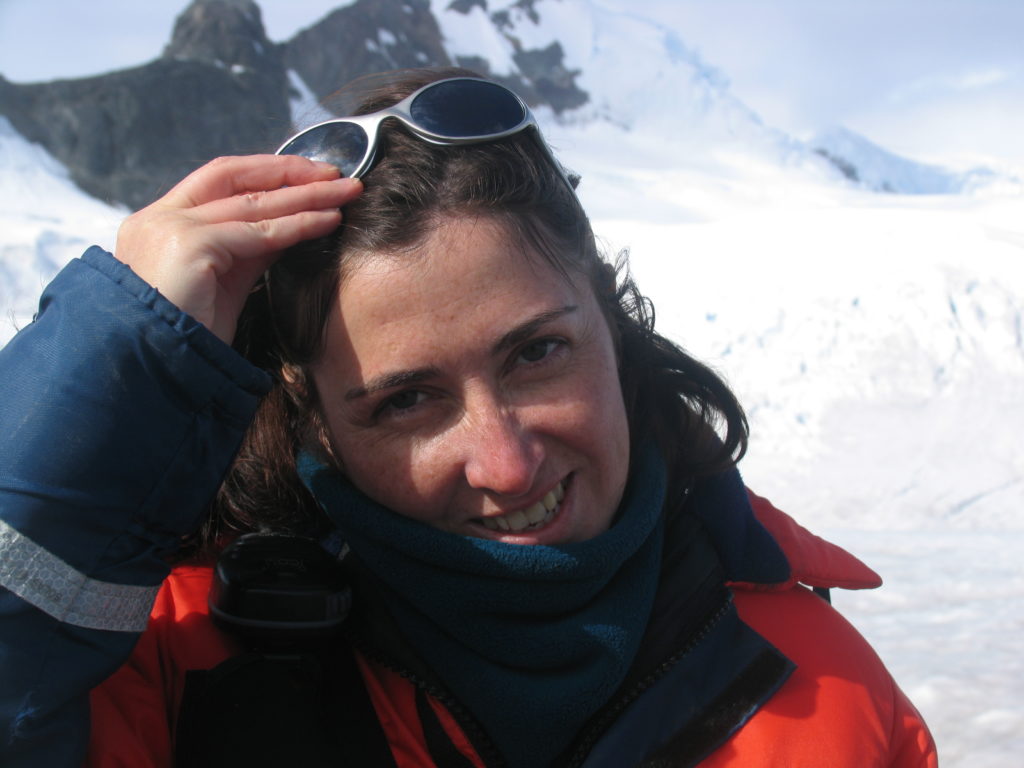

Madeline Armstrong
Discipline: Marine genomics
Age: 26
Nationality: USA
Organisation: Central Michigan University (USA)
Regional focus: Antarctic
Social media: ResearchGate and LinkedIn
What’s the work that you do?
Currently, my work is focused on phylogeography of Antarctic Pycnogonida, or sea spiders. We are looking at population genetics of species and also increasing our genetic reference libraries. Additionally, I am working on an eDNA metabarcoding project to look at baseline biodiversity of the Southern Ocean and potentially making this a long-term project to monitor changes in biodiversity due to climate change.
What keeps you going?
Uncovering the mysteries of Antarctica and the Southern Ocean. It is the most beautiful and awe-inspiring place and it desperately needs help to stay that way. I also just love to learn in general and meeting incredible researchers is just icing on the cake.
What’s your message to the world?
Everyone can be a scientist- no matter what. You don’t have to have a certain IQ or go to certain schools, you can do this. Science needs you.
Kathryn Adamson, PhD
Discipline: Quaternary science
Age: 35
Nationality: UK
Organisation: Manchester Metropolitan University (UK)
Regional focus: Arctic
Social media: Twitter
What’s the work that you do?
My research examines the impacts of Quaternary climate change on glaciers and river systems. I am mostly a field-based researcher, but I use a range of analytical approaches including geomorphology, sedimentology, geochemistry, and geochronology. Much of my current work focuses on the Arctic and sub-Arctic where I’m working on Holocene glacial geomorphology and proglacial lake sediment analysis. Other recent and on-going projects also include field sites in Britain and Ireland, North America, the Mediterranean, and Egypt.
What keeps you going?
The things I love most about my job are: 1) The variety! Every day is different. In any given week I’ll be in the lab, writing, teaching undergraduates and postgraduates, delivering public lectures… 2) The fieldwork. I have been incredibly lucky to work in some amazing parts of the world with great colleagues. One of the most important parts of my work is being able to see earth surface processes in action. 3) The lifelong learning. There is always something new to explore, whether it’s a new field site, new analytical technique, or new journal paper to read.
What’s your message to the world?
The natural world is infinitely fascinating. It is incredibly complex and interconnected on so many scales, from the big polar ice sheets to urban green space right outside the window. And we are just a small part of it. There is still so much to learn about the planet – never stop wondering!

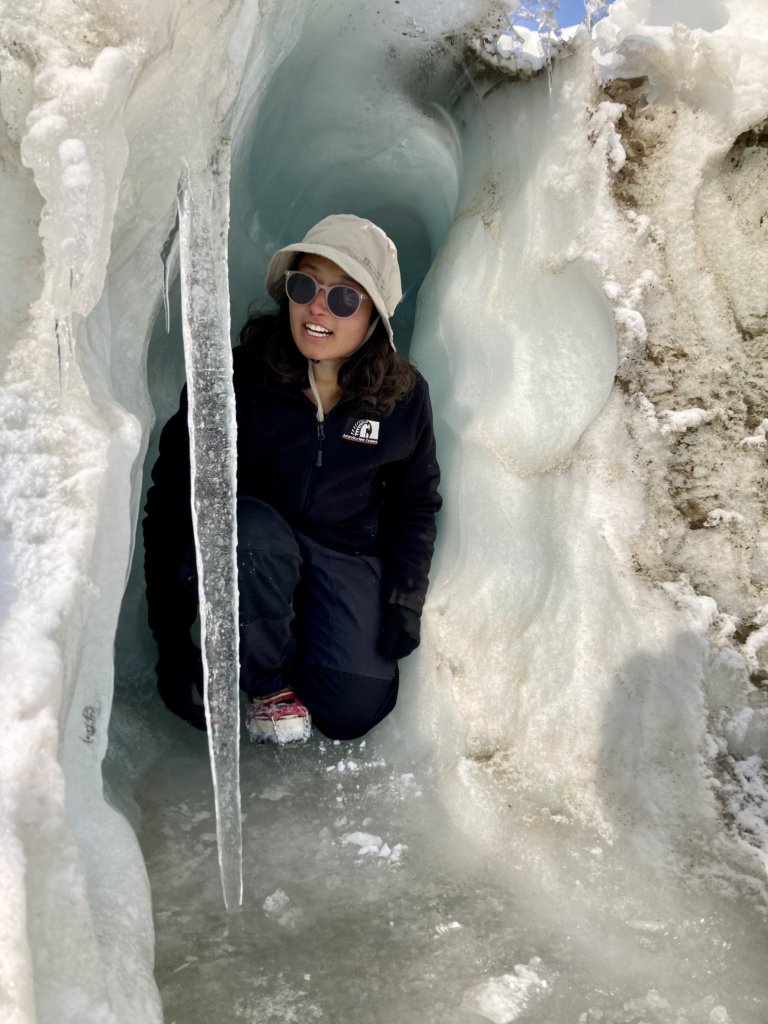
Tamara Pletzer
Discipline: Meteorology, glaciology and hydrology
Age: 26
Nationality: Austria
Organisation: Otago University (New Zealand)
Regional focus: Antarctic
Social media: Instagram and Twitter
What’s the work that you do?
I am a PhD candidate in Geography at University of Otago in New Zealand. The aim of my research is to implement a glacial meltwater model in the McMurdo Dry Valleys of Antarctica in order to model the ephemeral streams that provide freshwater for the unique microbial ecosystem.
What keeps you going?
I love being able to work on a multi-disciplinary project and on a topic that I am passionate about. I enjoy the day to day challenges of coding and solving equations along with appreciating the beauty of the glaciers and this region. Last season, I spent 6 weeks conducting field work and camping in the Dry Valleys. Being able to see the melt and the complex ways the meltwater drained from the glaciers helped me to better understand the physical processes of melt as well as the limitations of the model I’m working on. Field work also allows me to step out of my comfort zone, learn new skills and step into leadership roles.
What’s your message to the world?
It’s important to find something you love and that you can constantly learn from. And to work in a team of passionate, creative and collaborative people.
Elizabeth Silvestre Espinoza, PhD
Discipline: Environmental management
Age: 55
Nationality: Peru
Organisation: INCLIMA (Peru)
Regional focus: Antarctic
Social media: Twitter and LinkedIn
What’s the work that you do?
Most recently, I was the National Coordinator of the Peruvian Antarctic Program (2019-20), focusing on its management to support and facilitate the scientific results of the expedition. Currently I’m working in climate change and risk management, focused on extreme meteorological events, designing, implementing and managing Early Warning Systems. My position is Research Director at INCLIMA, an NGO that promotes and supports the development of applied research in climate change.
What keeps you going?
Meteorology is a dynamic science, and that’s why we are faced with challenges all the time. Understanding and managing why the climate behaves as it does and what its impacts are is a complex undertaking. I do my work because I believe that properly managed and applied science can solve and/or minimize the impacts of the climate on us humans.
What’s your message to the world?
The global climate system is physically and dynamically connected and in balance. For this reason, taking care of Antarctica means doing a lot that benefits other regions too.
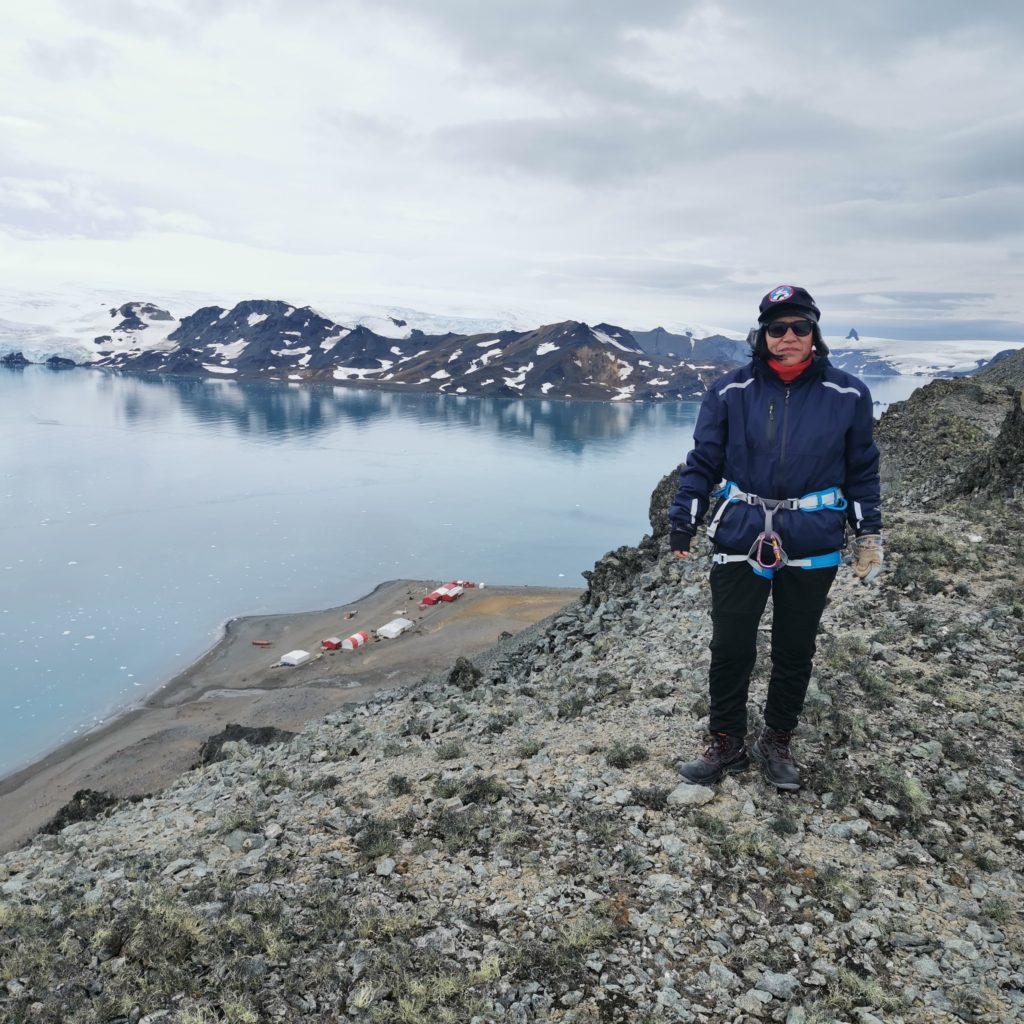
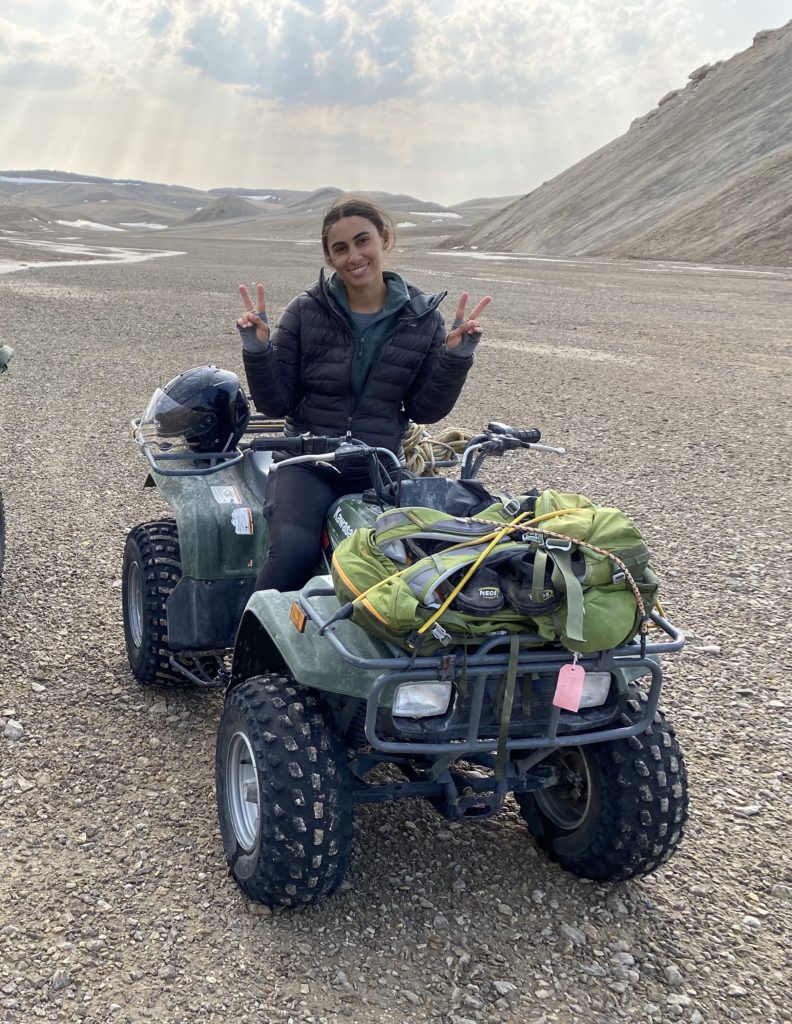
Simona Ruso, MSc
Discipline: Earth Science, Planetary Science & exploration
Age: 27
Nationality: Canada
Organisation: University of Western Ontario (Canada)
Regional focus: Arctic
Social media: LinkedIn and Twitter
What’s the work that you do?
My PhD research focusses on using the Arctic as an analogue for Mars. Specifically, I’m utilizing the morphology and distribution of subglacial channels in the Canadian Arctic Archipelago to identify certain locations on Mars that may have undergone glaciation. Both Mars and the Arctic are polar deserts, and features have been identified on Mars that bear striking resemblance to terrestrial glacial landforms. My work aims to explore Arctic subglacial channels and develop a diagnostic criteria that can be used to identify subglacial channels on Mars. In this way, my work may help us to understand the history of Mars’ climate.
What keeps you going?
I love being a part of exciting, innovative research in my home country and being able to apply it to other planetary bodies! Having the opportunity to explore the Canadian Arctic is something that not a lot of people get to experience, and I feel very lucky to be able to call this my job. It’s also important to be a part of this research as a woman in STEM, and setting the example for younger girls that want to do research and get out into the field!
What’s your message to the world?
Doing what love you means you will never work a day in your life. While any career is taxing mentally and physically at times, I believe in doing what excites you and choosing your own path.
Naomi Krauzig, PhD
Discipline: Oceanography
Age: 30
Nationality: Germany
Organisation: University Parthenope of Naples (Italy)
Regional focus: Antarctic
Social media: Twitter and ResearchGate
What’s the work that you do?
I’m a passionate physical oceanographer, investigating long-term and abrupt changes of our oceans and their role in the climate system. Currently, I’m involved in several research projects that assess important water masses in the Southern Ocean and the Ross Sea. These water masses impact, among others, the stabilizing ice shelves that surround the Antarctic Ice Sheet as well as the global thermohaline circulation.
What keeps you going?
The mysteries of the vast ocean have amazed me since my grandfather introduced me to diving as a little girl. Since then, my passion to understand and protect the foundation of all life has only grown. Isn’t it incredible that more people have reached the moon than the people that have reached the deepest part of our ocean on Earth? There is still so much we don’t know and so much we haven’t seen… Even more so in a unique environment like Antarctica!
What’s your message to the world?
Even though it sometimes feels like it is a different planet entirely – changes that occur in polar regions will, with certainty, have a global impact in the coming decades. And while many of us do research for the sheer beauty of it, we need to focus a majority of our efforts on the most pressing matters – collectively and inclusively.

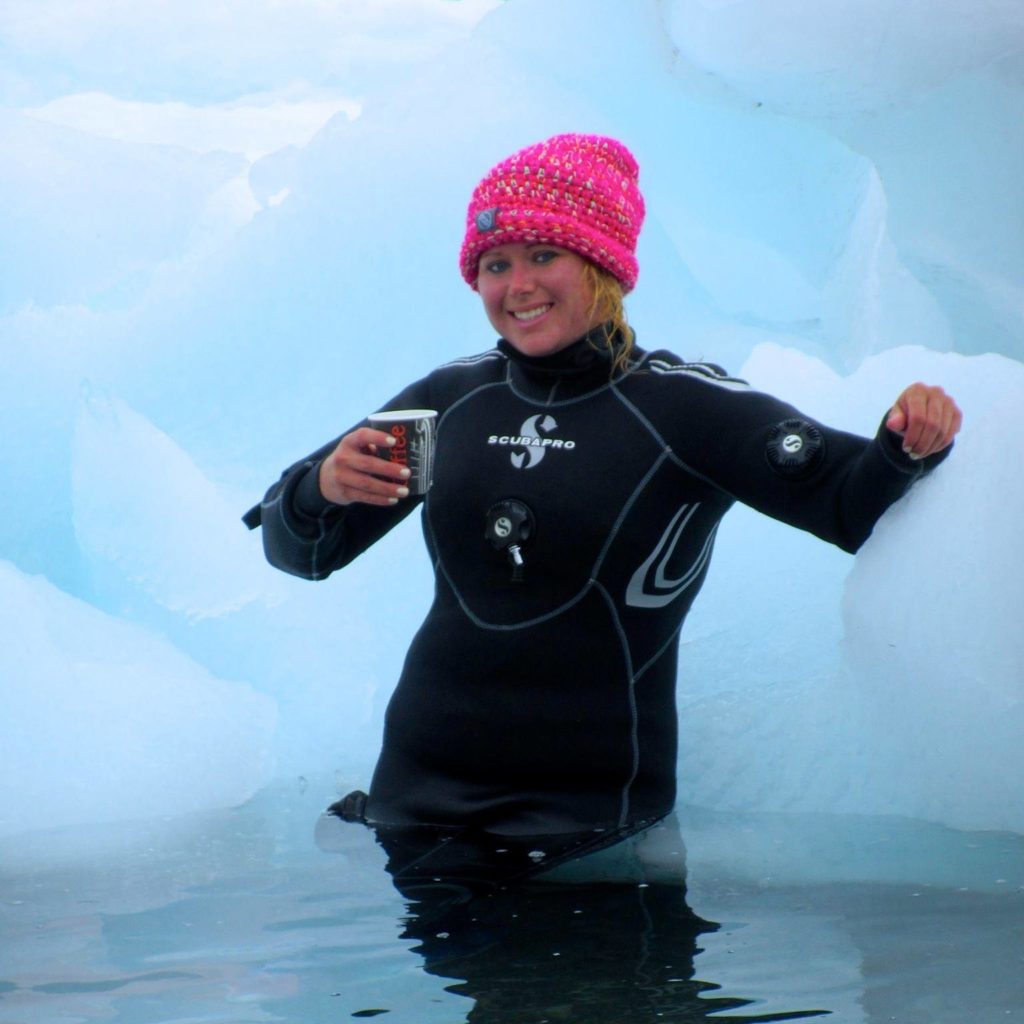
Captain Breezy Grenier, FRGS, MN’17
Discipline: Science, Exploration, Academic Support
Age: 34
Nationality: USA
Organisation: Breezy SEAS (contractor, self employed, seapreneur)
Regional focus: Arctic and Antarctic
Social media: Instagram and LinkedIn
What’s the work that you do?
My passion for the polar regions started when stationed in Alaska with the U.S. Coast Guard in 2006. Since I have worked from both land and sea, from the Geographic North Pole down to Antarctica. To encompass my diverse background, I started my own contract and consulting business, Breezy SEAS. I hold my 200-ton captains license and do everything from expedition logistics and planning; training development; joining research vessels and scientific expeditions as a field researcher or marine technician; operating zodiacs and serving as a field guide for ecotourism ventures; and science communication, hosting and creating education and outreach programs.
What keeps you going?
I make the joke that my father was from Canada, so I have maple syrup running through my veins and therefore I can withstand cold temperatures better than most. My life’s course has been anything but calm seas, constantly having to pivot and adapt to personal demise. I took every opportunity that I could, which put me in a unique position, with a broad range of knowledge and skills. Not one day is the same working in multiple industries across several disciplines. Building bridges in the Blue Economy, my drive always has been to explore. We discover most when working together.
What’s your message to the world?
Humans are the most adaptable beings on the planet. We have explored the reaches of space to the depths of our oceans. We can withstand temperatures from below freezing to unbearable heat. Do not let life’s hazards stop you from accomplishing your dreams. Each allision just gives you a new set of skills and knowledge to grow and learn from, to help you better navigate your future.
“Smooth seas never made a skilled sailor” -Franklin D. Roosevelt
